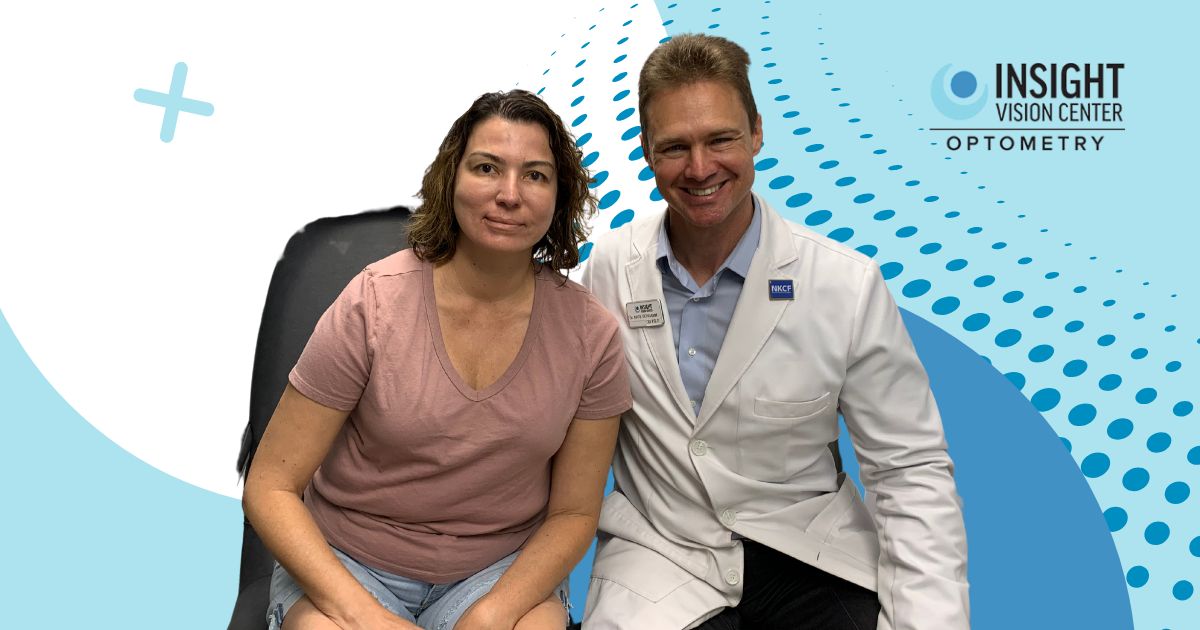
The Highest Rated Specialty Eye Care Center In Orange County

What Our Patients are Saying
“Dr. Mai and the entire personnel are amazing! Extremely polite, kind and professional. In addition, I can now see 20/20!!! Thank you, thank you all. 🤗🤗””
⭐⭐⭐⭐⭐
Franchezka
“Dr Mai and his team are awesome. They’re the best doing tests because, have the ultimate equipment with the last technology. And their customer service is unique “
⭐⭐⭐⭐⭐
Rene J.
Eye pain can be alarming and uncomfortable, often causing individuals and their families to worry about what might be behind these distressing sensations. Each year, over 5 million people seek medical attention for eye pain. While most cases aren’t a threat to vision, the vast majority still require treatment. Whether your eye pain is mild or severe, it’s crucial to take it seriously and visit an eye doctor promptly.
Eye Pain Should Never Be Ignored
Don’t ignore eye pain, especially if it’s accompanied by other serious symptoms. It’s important to see an eye care professional right away for the following reasons:
- Potential Seriousness: Eye pain can be an early warning sign of vision-threatening conditions. Early diagnosis and treatment can prevent permanent damage.
- Complexity of Causes: With numerous possible causes ranging from harmless to severe, a professional evaluation is necessary to identify the exact issue.
- Effective Treatment: Appropriate treatment—whether medication, therapy, or surgery—can relieve pain and effectively address the underlying cause.
- Even Minor Issues Need Attention: Conditions like corneal abrasions and eye infections may start as minor problems, but delaying treatment can lead to more serious complications.
Conveniently situated in Costa Mesa, we attract patients from across Orange County, including Irvine, Huntington Beach, and Santa Ana, for emergency eye care treatment.
Different Types and Causes of Eye Pain
Eye pain can present itself in various forms, impacting different parts of the eye and surrounding areas. It can manifest as a dull ache, a sharp stabbing pain, burning sensation, or even as a sensation of pressure. Understanding the nature of eye pain is the first step in addressing it effectively.
Ocular Pain
This type usually affects the outer surface of the eye caused by factors like infections, trauma, or foreign substances.
Orbital Pain
Experienced deeper within the eye, often indicating more serious conditions requiring extensive medical evaluation.
Notably, eye pain can also be classified based on its location and other symptoms like redness, discharge, or changes in vision. Here are some common forms:
- Corneal Injuries: These include abrasions or scratches resulting from foreign objects or improper contact lens use.
- Chemical burns and injuries: Injuries from chemicals to the eye cause significant pain and can cause serious damage. Immediately flush the eye for 20 minutes and visit an eye doctor without delay.
- Infections: Conditions such as conjunctivitis (pink eye) and blepharitis lead to inflammation and discomfort both on the surface and inside the eye.
- Inflammatory Conditions: Internal eye issues like iritis and optic neuritis contribute to significant pain and require targeted medical care.
Common Experiences and Symptoms
Patients often experience a range of symptoms accompanying their eye pain, each suggesting different possible underlying causes:
- Foreign Objects: The presence of foreign particles like sand or dust can cause immediate irritation and pain. The eyes typically flush these naturally, but persistent discomfort might require medical intervention.
- Dry Eyes: This condition results in grittiness, scratchiness, and burning sensations, often exacerbated by prolonged screen time or environmental factors.
- Light Sensitivity: Increased sensitivity to light can indicate more serious underlying issues like migraine or glaucoma.
- Nausea and Vision Changes: Accompanied by eye pain, these symptoms necessitate immediate evaluation as they might indicate acute conditions like angle-closure glaucoma or elevated intraocular pressure.

Experiencing Unexplained Eye Pain? Our Team of Eye Doctors Can Help
At Insight Vision Center Optometry, our eye doctors—Dr. Nathan Schramm, Dr. Ariel Chen, Dr. Valerie Lam, and Dr. Nhi Nguyen—specialize in providing emergency eye care for eye pain. With years of experience in diagnosing and treating urgent eye conditions, our team is dedicated to offering fast, expert care to alleviate your discomfort and protect your vision during emergencies.
Types of Eye Pain
Experiencing eye pain can be a troubling and distressing occurrence, whether it arises from the outside or lurks within. Understanding the various forms of eye pain is crucial in determining the appropriate steps for relief. Here, we categorize eye pain into two main types: ocular pain and orbital pain, each with distinct characteristics and underlying causes.
Ocular Pain
Ocular pain refers to discomfort or pain originating from the outer surface of the eye. It’s often associated with external factors or readily visible conditions. This type of pain can commonly be attributed to:
- Foreign Substances: Environmental irritants, such as dirt, dust, or even the occasional eyelash, can invade the eye’s surface causing irritation, redness, and watery eyes. Although many are easily removed by blinking, should discomfort persist, a simple rinse with saline solution can help. Refrain from using fingers to avoid causing corneal abrasions.
- Corneal Abrasions: When a foreign object causes a scratch, it leads to this common ocular pain characterized by tearing, redness, and light sensitivity. While many abrasions heal with time, preventing infection is vital.
- Conjunctivitis: Known commonly as pink eye, this infection inflames the conjunctiva and causes redness and discharge. Prompt treatment often includes topical medications and rest.
- Dry Eyes: Poor tear production can result in dry, scratchy sensations that become painful if untreated. Often managed with appropriate eye drops.
- Blepharitis: An infection of the eyelids which may be anterior or posterior, leading to burning, itching, and light sensitivity. Good eyelid hygiene can help reduce frequent recurrences.
- Styes: Painful bumps caused by clogged glands around the eye. Warm compresses can alleviate symptoms, but avoid makeup and contact lenses during flare-ups.
Orbital Pain
Orbital pain is deeper, often described as a sensation of pain behind the eye. This type of pain usually signals a need for greater medical scrutiny as it can be indicative of serious eye conditions:
- Glaucoma: Often silent until advanced, acute angle-closure glaucoma causes sudden severe eye pain due to a rapid increase in intraocular pressure. Immediate medical intervention is necessary to avoid irreversible damage.
- Migraines: Eye pain associated with migraines can include visual anomalies and demands a holistic approach to treatment including rest and medications.
- Optic Neuritis: Inflammation of the optic nerve, often linked with autoimmune conditions, leads to significant pain and potential vision loss. While some cases resolve independently, treatments are available.
- Iritis: An inflammation of the iris causing internal pain that can affect one or both eyes. It’s less severe but still requires medical attention.
Manifestations of Eye Pain
Identifying eye pain can be subtle, often manifesting in varied presentations that may occur in one or both eyes. Recognizing these symptoms is critical:
- A dull ache or a stabbing, sharp sensation
- Burning or irritation
- Redness or bloodshot appearance
- Increased sensitivity to light
Given the diverse range and causes of eye pain, it’s essential to seek prompt assessment and intervention. Local optometrists and emergency eye care services are equipped to provide the necessary evaluations and treatments to safeguard your vision and relieve discomfort.
Linking Eye Pain with Symptoms and Potential Causes
Eye pain can be caused by many different conditions and behaviors, contextualizing the eye pain can help identify possible causes.
Contact lens use
Possible causes: Corneal abrasion, keratitis, bacterial conjunctivitis.
Decreased vision
Possible causes: Optic neuritis, scleritis, keratitis, uveitis, acute angle-closure glaucoma, cellulitis.
Foreign body sensation
Possible causes: Corneal abrasion, dry eye syndrome, keratitis, retained foreign body.
Headache
Possible causes: Acute angle-closure glaucoma, scleritis, cluster headache, migraine.
Photophobia/light sensitivity
Possible causes: Keratitis, uveitis, corneal abrasion, migraine, acute angle-closure glaucoma.
Stabbing eye pain
Possible causes: Scleritis, cluster headache.
Systemic inflammatory or autoimmune disease
Possible causes: Scleritis, uveitis, optic neuritis.
Eyelid swelling
Possible causes: Hordeolum, orbital cellulitis, preseptal cellulitis.
Increased intraocular pressure
Possible causes: Acute angle-closure glaucoma.
Pain with eye movement
Possible causes: Optic neuritis, orbital cellulitis, scleritis, acute angle-closure glaucoma.
Common Causes of Eye Pain
Eye pain can be distressing and troublesome, impacting the quality of life for both adults and children. Whether you feel discomfort from burning, itching, or stabbing sensations, understanding the underlying cause is essential for effective relief. Let’s explore some common categories of eye pain to help you pinpoint the source and seek appropriate care.
Superficial Eye Pain
Superficial eye pain affects the eye’s surface and usually stems from less severe issues:
- Foreign Objects: Small irritants like sand or an eyelash can cause pain, redness, and watering. If discomfort persists, rinse the eye with water or artificial tears, but avoid rubbing.
- Blepharitis: Inflammation at the eyelid edges, often due to clogged oil glands, can cause swelling and irritation. Treatment involves good hygiene and may require ongoing care.
- Sty: An infection in the eyelid glands leads to a painful bump. Treatments include antibiotics or professional drainage.
- Corneal Injury or Dry Eyes: Scratches or damage to the cornea need prompt treatment with eye drops. Untreated dry eyes might lead to further pain or damage.
- Conjunctivitis: Also known as pink eye, this causes inflammation with symptoms like redness and discharge. Treatment varies based on the cause.
Internal Eye Pain
Internal eye pain signals deeper issues that may be serious:
- Glaucoma: High pressure inside the eye affects the optic nerve, with closed-angle glaucoma requiring emergency care due to severe pain and other symptoms.
- Penetrating Eye Injury: A foreign object piercing the eye necessitates immediate professional care to prevent further damage.
- Optic Neuritis: Inflammation of the optic nerve, often linked to autoimmune disorders, can cause pain and vision loss.
- Iritis: Inflammation of the iris requires medical attention to avoid complications, even in healthy individuals.
Undetected Functional Vision Problems
Functional issues often related to extensive reading or screen use can also cause eye pain:
- Vision Misalignment: Problems with eye teaming or focusing can strain eye muscles, causing pain or headaches.
- Light Sensitivity: Poor light management can cause discomfort, requiring adjustments in lighting.
- Fatigue-related Pain: Extended focusing activities can overwork the eye’s focusing system, leading to discomfort.
Persistent or sudden eye pain should not be ignored as it could indicate serious conditions. Recognizing these common causes helps in seeking timely and appropriate treatment from an eye care professional.
Superficial Eye Pain: Causes and Solutions
Experiencing eye pain from the surface of the eye, known as superficial eye pain, can arise from infections, trauma, or irritants. Prompt treatment helps maintain eye health. Here’s a breakdown of common causes and solutions:
- Foreign Objects: Items like sand or eyelashes can cause irritation. While tears often remove these naturally, persistent discomfort or larger objects may require a doctor’s visit to avoid scratches or deeper injuries. Avoid rubbing the eyes.
- Blepharitis: This condition involves inflamed eyelids due to clogged or infected oil glands, leading to redness and irritation. Managing it includes maintaining eyelid cleanliness, using warm compresses, or medicated drops.
- Corneal Injury: Injuries like scratches from touching the eye with dirty hands cause sharp pain and redness. Minor scratches typically heal independently, but severe injuries like corneal ulcers need immediate treatment to prevent vision loss.
- Dry Eye Syndrome: Symptoms like gritty or itchy eyes suggest dry eye syndrome, where insufficient tear production leads to irritation. Solutions include using artificial tears, adjusting the environment, or consulting a specialist for advanced treatments.
- Contact Lens Irritation: Mismanagement of contact lenses can lead to irritation. Following proper lens care and consulting an eye doctor for persistent issues is crucial.
- Conjunctivitis (Pink Eye): This infection causes redness, itching, and discharge. Treatment varies with the cause, ranging from antibiotics for bacterial infections to supportive care for viral infections.
Internal Eye Pain: Causes and Solutions
- Glaucoma: Eye pain could signal glaucoma, a serious condition where increased eye pressure can damage the optic nerve. Regular eye exams are vital as early detection can prevent vision loss, especially from acute angle-closure glaucoma, which causes sudden pain and vision issues and requires immediate treatment.
- Optic Neuritis: This condition involves inflammation of the optic nerve, causing pain, especially with eye movement, and potential vision loss. It is often linked to autoimmune diseases like multiple sclerosis. Immediate medical treatment can help speed recovery and alleviate symptoms.
- Iritis: Iritis, or anterior uveitis, is the inflammation of the iris, leading to pain, light sensitivity, and possibly headache. It may stem from autoimmune disorders, trauma, or infections, and is typically treated with prescription eye drops to reduce inflammation.
- Sinusitis and Other Infections: Sinusitis can cause eye pain due to the close proximity of sinus cavities to the eyes. It often comes with symptoms like facial pain and nasal congestion. Eye specialists can provide treatments that address both the sinus condition and associated eye discomfort.
- Migraines: Migraines can affect eye health, causing visual disturbances and pain behind the eyes. Those experiencing frequent migraines should seek medical advice to manage the effects on vision and overall eye health.
Treatments and Relief for Eye Pain
Experiencing unexplained eye pain can be distressing, especially when it’s sudden or persistent. But don’t worry! Our specialized eye care center is here to help you uncover the cause and find effective relief solutions tailored to your needs. Whether you’re a patient seeking relief or a healthcare professional referring a case, we understand your concerns and are committed to providing the best possible care. To prevent complications and rule out more serious conditions it is always recommended to see an eye doctor as soon as possible for eye pain. If you are unsure if your symptoms warrant an evaluation please call us for more specific guidance.

Initial Steps for Eye Pain Relief
When faced with eye pain, it’s crucial to take immediate and appropriate action. First, refrain from rubbing your eyes as this could exacerbate any existing conditions, such as corneal abrasions. Instead, begin by gently rinsing your eyes with clean water or using artificial tears to remove any small irritants. If your symptoms persist, contact your eye care provider promptly to identify the root cause and best course of action.
Medications and Eye Drops
Medications and eye drops can provide significant relief for various types of eye pain. For instance, antibiotic eye drops are often prescribed for bacterial infections like conjunctivitis or styes, reducing symptoms and preventing complications. If you’re dealing with inflammation or irritation, over-the-counter or prescription anti-inflammatory drops might be recommended. Remember to consult your eye care specialist for the most effective treatment for your specific condition.
Use of Warm and Cold Compresses
Applying warm or cold compresses can be a simple yet effective method for alleviating different types of eye discomfort. Warm compresses are particularly beneficial in reducing inflammation associated with styes and blepharitis by promoting drainage and soothing the affected area. On the other hand, cold compresses can help decrease swelling and relieve pain in cases of trauma or irritation. Always ensure the compress is clean and applied gently to avoid further irritation.
Hydration and Rest
Maintaining adequate hydration and ensuring sufficient rest are essential components of eye health. Dehydration can lead to dry eyes, which may further exacerbate pain and discomfort. Drinking ample water throughout the day can help keep your eyes moist and reduce the risk of dryness. Additionally, giving your eyes plenty of rest—especially from digital screens—can prevent strain and fatigue. Adopting the 20-20-20 rule, where you take a 20-second break to look at something 20 feet away every 20 minutes, can significantly aid in reducing eye strain.
With the appropriate interventions and expert guidance, alleviating eye pain becomes a manageable endeavor. Trust our experienced team to guide you through treatment options and help safeguard your eye health and well-being. Immediate consultation with your eye care provider is crucial to address any lingering or severe symptoms effectively.

Urgent Eye Care Specialists in Costa Mesa
When it comes to emergency care for eye pain, Insight Vision Center Optometry stands out as the top choice in Orange County. Located in Costa Mesa, our state-of-the-art facility is trusted by patients from nearby cities such as Irvine, Huntington Beach, and Santa Ana. Our experienced eye doctors are available to provide urgent treatment specifically for eye pain, ensuring prompt attention to this concerning symptom. For those in need of immediate care, our clinic is fully equipped with advanced technology to diagnose and manage eye pain swiftly and effectively, safeguarding your vision and eye health.
Call us at (714) 942-1361 to book your child’s appointment, or schedule online.





